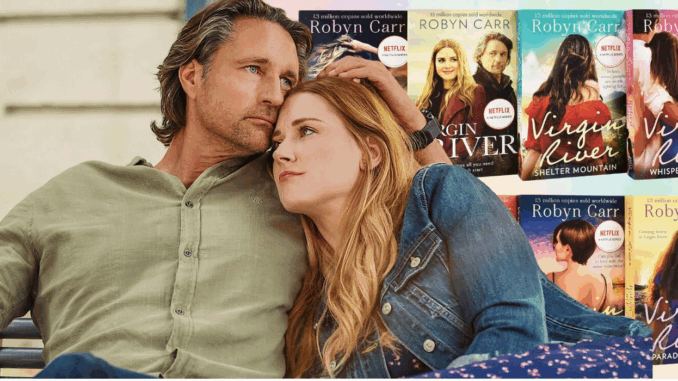
Fans of Virgin River have fallen in love with its cozy small-town charm, heartwarming relationships, and emotional storytelling. But for those who’ve read Robyn Carr’s bestselling book series, the Netflix adaptation tells a very different version of life in the quiet Northern California town. From character changes to major plot twists, here are seven big differences between the Virgin River books and the Netflix series that even the most loyal fans might not know.
1. Mel’s Backstory Is Much Darker on Netflix
In the Virgin River books, Melinda “Mel” Monroe moves to Virgin River after her husband’s tragic death, hoping to start fresh. However, the show expands her trauma significantly. Netflix’s Mel not only grieves her husband Mark but also suffers a miscarriage and years of infertility struggles. This deeper, more emotional layer gives the series a raw, human depth that wasn’t as heavily emphasized in the novels.

2. Jack’s Character Is Completely Reimagined
Jack Sheridan in the books is older, more grounded, and already retired from the Marines when he meets Mel. In the show, he’s younger, still haunted by his military past, and struggling with PTSD. This change adds emotional conflict — his trauma shapes his relationship with Mel, making their love story feel more fragile and real. The TV Jack isn’t just the town’s hero; he’s a man trying to heal.
3. Charmaine’s Storyline Is Wildly Different
Perhaps the biggest shock to book fans is Charmaine Roberts. In the novels, she’s a minor character who never has Jack’s babies — in fact, her role is mostly to create brief tension before moving on. The Netflix version turns her into one of the show’s central figures, introducing the now-infamous twin pregnancy twist and her ongoing rivalry with Mel. This drama-filled expansion adds layers of suspense that the book never touched.
4. Doc and Hope’s Relationship Doesn’t Exist in the Same Way
In the Virgin River books, Doc Mullins is married to a woman named June, who’s kind, stable, and supportive. The Netflix show completely reinvents this storyline by introducing Hope McCrea, the town’s feisty mayor. Their bickering yet loving relationship is one of the show’s highlights, providing humor and emotional balance to the darker storylines. Hope doesn’t exist in the original novels — she’s a brilliant TV creation.
5. Paige Lassiter’s Arc Takes a Dark Turn
Paige, the baker who runs the local food truck, has one of the most intense stories on Netflix. Her experience as a domestic abuse survivor and her eventual disappearance make her one of the most complex characters in the show. In contrast, her book counterpart has a much softer storyline centered around love and motherhood. The show gives her a powerful, if painful, voice that resonates deeply with viewers.
6. The Tone of the Books vs. The Series
The Virgin River novels are comforting and romantic, focusing on community, healing, and love. The Netflix series, while still heartwarming, leans more into melodrama — unexpected pregnancies, mysterious deaths, missing people, and even shootings. This shift makes the show feel more like a small-town soap opera with a cinematic edge, appealing to a broader audience while maintaining the emotional warmth of the source material.
7. New Characters and Stories That Don’t Exist in the Books
Netflix’s Virgin River adds several original characters who never appeared in Robyn Carr’s novels — like Brady, the troubled ex-Marine; Lizzie, the rebellious teen; and Preacher’s expanded backstory. These additions enrich the town’s tapestry, introducing modern themes like addiction, PTSD, and the search for belonging. The result is a more layered, emotionally complex version of Virgin River that feels both timeless and timely.
Conclusion: Two Versions, One Heart
The Virgin River books and the Netflix series may tell their stories differently, but both share the same heart — the healing power of love, community, and hope. Robyn Carr’s novels created a world that felt like home; the Netflix adaptation simply brought that home to life in a new way, with more drama, deeper pain, and unforgettable characters.
Whether you’re a longtime fan of the books or you discovered Virgin River through the show, one thing is certain: no matter how it’s told, the magic of Virgin River always lies in its people — flawed, kind, and forever seeking a fresh start.
